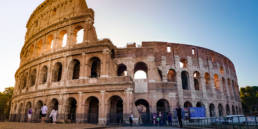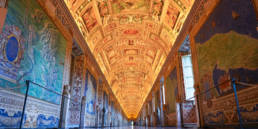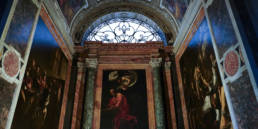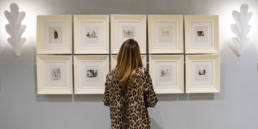My exploration of Ancient Rome in 2004 was motivated by wanting to better understand Renaissance art. What you have here is a rather partial review of things to see, since there is no commentary on the very large and important fora (the Roman forum and the Imperial forum).

UPDATE Spring 2009: This page is now out of date. Please see individual posts in the Rome section.
Nero’s Domus Aurea
In AD 64-68, the nasty dictatorial Emperor Nero built himself this pleasure palace on the ruins of the city he burned down. Nice guy! He employed the architect Severus and the painter Fabullus. The huge expanse of connected vaulted chambers that is now underground was the ground level of the palace; a second level was destroyed by subsequent emperors. Nero’s private artifical lake was removed to make way for the nearby Colosseum. The lower level was filled by sand and used as the foundation for a subsequent palace.
In the mid 1490’s some holes opened up in the ground of a park, and Renaissance artists, amongst the first of them Pinturricchio, crawled down into these “grottoes” and observed their colorful, unusual frescoes, which they named “grotesques”. These were the inspiration for the grotesques that cover so many square miles of ceiling and wall space in the Renaissance, and is particularly interesting to me since I study decorative complexes. Grotesques vary depending on the period (both in Roman and Renaissance times) but is characterized by an impossible, fantastic combination of creatures that titillated artistic minds.
The Domus Aurea is definately worth the visit for anyone interested in Renaissance art (not to mention Ancient Roman!), though for fullest appreciation it requires some preparation – it helps to know something about ancient wall painting, so you might consider reading up with this book: Robert Ling’s Roman Painting. As an instance of ancient architecture it is a bit confusing because it is a partial structure (remember one floor was destroyed) and also only partially excavated. Study the map, but don’t try to orient youreslf. As for the frescoes, you need to imagine what this would have been like for those who crawled through in the fifteenth century — the frescoes were brilliantly coloured in reds and orchres (having not been exposed to oxygen for 1450 years) and must have been like nothing ever seen before. The effect would have been amazingly colourful and sumptuous. Imagine the excitement! To get an idea of what these were like, there is an informative panel in colour at the entrance to the site. You should also go see the contemporary frescoes from the house of Livia at Palazzo Massimo.
The domus aurea is currently a restoration site but is open for viewing upon reservation. Information can be found on the official website of the soprintendenza. In case you don’t want to slog through that italian, you can purchase your reservation through this official website.
The Pantheon
Started 27-25 BC; The first building was comissioned by Agrippa, Augustus’ son, but it and a few subsequent versions burned down. The present version, built by Hadrian ca 118-28, has an inscription that commemorates the founding patron rather than himself. I approached the building and its accompanying hoarde of tourists from behind, where the shift in ground level is particularly apparent.
The huge, heavy semi-spherical dome does not seem so heavy because the building is so well balanced – in fact, it is the same height and width (43.3 metres). When one considers that the opening at its centre is 9m wide, this dome is massive, and a true feat of engineering that dazzled renaissance architects and modern-day tourists alike. It’s even bigger than Michelangelo’s dome at St. Peter’s. The side chapels contain an unfortunate mish mash of 14th through 19th century objects.
Building open all day, entrance free!
Temples at Largo Argentina

Many busses and trams stop at Largo Argentina, in the middle of which is an archaeological area that was discovered during ‘renovations’ in 1926. The photo shows a cat licking itself with the backdrop of the ruins of Temple “A”. There is a cat sanctuary at one end of the archaeological site; you can visit the poor abandoned cats in the shelter during morning hours, though it’s rather smelly. The cats have the run of the temples, whereas we do not, so they (the cats AND the temples) can only be photographed from street level. Oh yeah, you want to know about the temples? Well, the four structures, imaginatively named A, B, C and D because not enough is known about their dedications, are a rare example of Republican architecture, ranging from the end of the 4th century BC to the end of the 2nd C BC.
Museum of Palazzo Massimo alle Terme
This museum contains some of the highest quality Roman art brought to light by 19th and 20th century excavations. The biggest highlights are the frescoes and mosaics displayed on the second floor, for which you are given a specific entry time. The detached frescoes from the private apartments of Augustus’ wife are a wonderful example of second pompeian style. On the first floor, good bilingual wall text leads you through sculpture arranged by theme. If you can read italian, there is an initiative directed at children that is informative and perceptive. It tells really fun stories in the first person about some of the more important works.Unfortunately, the visit to the second floor is compulsorily by guided tour, and you are given only 40 minutes to see it all. As you can imagine, in this time you SEE nothing, you only barely have time to glance. The tour guide is surely knowledgeable but only has time for the most basic of information, given first in quick italian and then in incomprehensibly accented but strangely fluent english. There are superb wall texts, if only you had time to read them.
Centrale Montemartini (Capitolone Museums satellite site)
This electrical plant, the first in Rome and built 1912, has been converted recently (1997) into a secondary museum space for the Capitoline Museum collections of sculpture during the main site’s rennovation.I admit, I was skeptical about this museum – I thought it would house “leftovers”. I was very pleasantly surprised and would recommend this to any interested tourists or scholars, especially fans of Ancient art. Not many people make it out here but it is worth it, and not really as out of the way as it seems. The power plant has been beautifully restored and interesting elements have been recuperated and duly labelled, providing for fascinating juxtapositions of the modern (all dark metal) and the ancient sculpture, usually not all that fun to look at in white rooms. If anything you’re bound to get good photos.
Amongst the more quality items in the collection is the famous Barberini “Togato”, a standing male sculpture of the first century representing a patrician man holding the busts of his ancestors – reflective of contemporary practise and privilege of the patrician classes to have these items made. However, since it is in itself a white marble sculpture, to us there is not much differentiation between the “real” and the “sculpted”, so that it rather disconcertingly looks like this man is holding two severed heads. His own head was also severed; the one on this sculpture is not the original.
My photos show some of the most interesting sculptures juxtaposed with power plant machinery: (1) Tosi (1933) and greek maiden; (2) the man with three heads described above; (3) the dials from a 1930’s diesel motor and (4) the handles; (5) a 1950’s furnace and, ironically, a Roman altar.
Lunch Suggestion: “Doppio Zeroo” wine bar, (via ostiense 68). A stylish but reasonably priced pizzeria/tavola calda/wine bar frequented by office workers (always a good sign).
On your way back to Piramide metro station, you can’t possibly miss the Piramide di Caio Cestio, a 27 metre high brick pyramid faced with white marble, and tucked into the city walls, which kinda takes away from the original effect.
Official website and opening hours at: www.centralemontemartini.org
Sign up to receive future blog posts by email
Alexandra Korey
Alexandra Korey aka @arttrav on social media, is a Florence-based writer and digital consultant. Her blog, ArtTrav has been online since 2004.
Related Posts
April 9, 2019
A Restoration Lab Tour and Caravaggio in Rome
February 1, 2017




